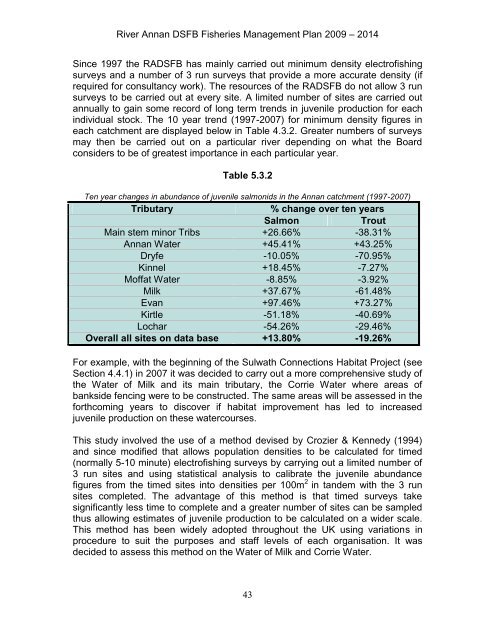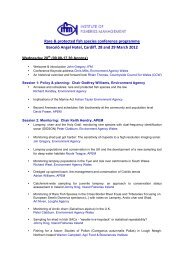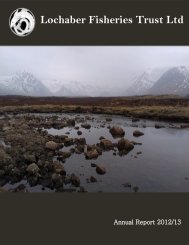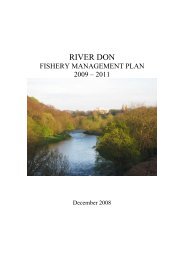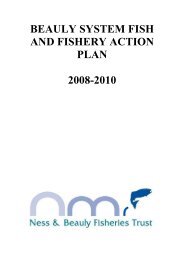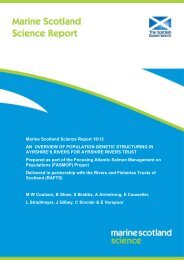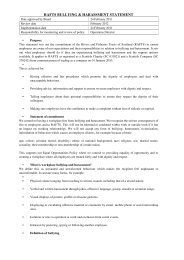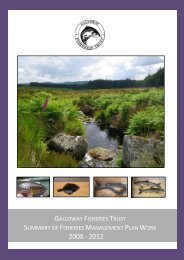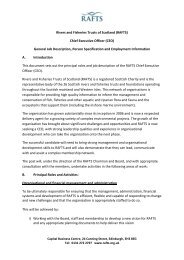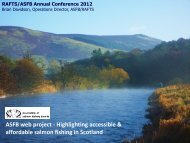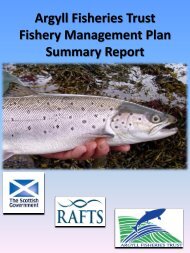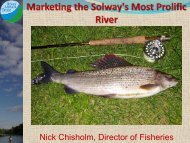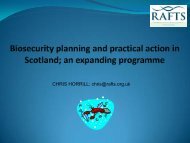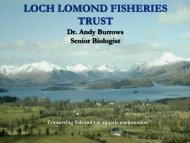You also want an ePaper? Increase the reach of your titles
YUMPU automatically turns print PDFs into web optimized ePapers that Google loves.
River <strong>Annan</strong> DSFB Fisheries <strong>Management</strong> <strong>Plan</strong> 2009 – 2014Since 1997 the RADSFB has mainly carried out minimum density electrofishingsurveys and a number of 3 run surveys that provide a more accurate density (ifrequired for consultancy work). The resources of the RADSFB do not allow 3 runsurveys to be carried out at every site. A limited number of sites are carried outannually to gain some record of long term trends in juvenile production for eachindividual stock. The 10 year trend (1997-2007) for minimum density figures ineach catchment are displayed below in Table 4.3.2. Greater numbers of surveysmay then be carried out on a particular river depending on what the Boardconsiders to be of greatest importance in each particular year.Table 5.3.2Ten year changes in abundance of juvenile salmonids in the <strong>Annan</strong> catchment (1997-2007)Tributary% change over ten yearsSalmonTroutMain stem minor Tribs +26.66% -38.31%<strong>Annan</strong> Water +45.41% +43.25%Dryfe -10.05% -70.95%Kinnel +18.45% -7.27%Moffat Water -8.85% -3.92%Milk +37.67% -61.48%Evan +97.46% +73.27%Kirtle -51.18% -40.69%Lochar -54.26% -29.46%Overall all sites on data base +13.80% -19.26%For example, with the beginning of the Sulwath Connections Habitat Project (seeSection 4.4.1) in 2007 it was decided to carry out a more comprehensive study ofthe Water of Milk and its main tributary, the Corrie Water where areas ofbankside fencing were to be constructed. The same areas will be assessed in theforthcoming years to discover if habitat improvement has led to increasedjuvenile production on these watercourses.This study involved the use of a method devised by Crozier & Kennedy (1994)and since modified that allows population densities to be calculated for timed(normally 5-10 minute) electrofishing surveys by carrying out a limited number of3 run sites and using statistical analysis to calibrate the juvenile abundancefigures from the timed sites into densities per 100m 2 in tandem with the 3 runsites completed. The advantage of this method is that timed surveys takesignificantly less time to complete and a greater number of sites can be sampledthus allowing estimates of juvenile production to be calculated on a wider scale.This method has been widely adopted throughout the UK using variations inprocedure to suit the purposes and staff levels of each organisation. It wasdecided to assess this method on the Water of Milk and Corrie Water.43


